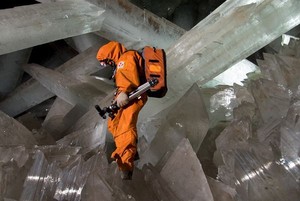Things for Unit 4 you should UNDERSTAND, KNOW, and be able to DO...

Understand:
• Observation and classification have helped us understand the great variety and complexity of rocks and minerals found on Earth.
• Rocks and minerals help us understand Earth’s historical development and its dynamics.
Know:
• The Earth can be divided into the atmosphere, hydrosphere and lithosphere. Rocks and minerals can be found in the Earth’s lithosphere.
• Minerals have physical properties determined by their chemical composition and crystal structure.
• Minerals can be identified by well-defined physical and chemical properties, such as cleavage, fracture, color, density, hardness, streak, luster, crystal shape, and reaction with acid.
• Chemical composition and physical properties determine how minerals are used by humans.
• Minerals are formed inorganically by the process of crystallization as a result of specific environmental conditions. These include: cooling and solidification of magma, precipitation from water caused by such processes as evaporation, chemical reactions, and temperature changes, rearrangement of atoms in existing minerals subjected to conditions of high temperature and pressure.
• Rocks are usually composed of one or more minerals.
• Rocks are classified by their origin, mineral content, and texture.
• Conditions that existed when a rock formed can be inferred from the rock’s mineral content and texture.
• The properties of rocks determine how they are used and also influence land usage by humans.
Vocab Terms: Banding, bedrock, burial, cementation, cleavage, compaction, contact metamorphism, crystallization, density, deposition, extrusive, felsic, foliation/foliated, fracture, hardness, igneous, intrusive, lava, luster, mafic, magma, metamorphic, mineral, rock, sediment, sedimentary, solidification, streak, texture (clastic, coarse, fine, glassy), uplift, volcanic
Do:
• experimentally determine density to identify a rock/mineral sample.
• observe properties (acid, magnetism, luster, hardness, streak, cleavage, fracture, color) to infer the identity of minerals by using ESRT p.16.
• observe properties of rocks and uses ESRTs (p. 6-7) to classify them as sedimentary, igneous, or metamorphic.
• demonstrate working knowledge of the rock cycle using the diagram on ESRT p.6
• compare rock type by environment of origin.
 Understand:• Observation and classification have helped us understand the great variety and complexity of rocks and minerals found on Earth.• Rocks and minerals help us understand Earth’s historical development and its dynamics.Know:• The Earth can be divided into the atmosphere, hydrosphere and lithosphere. Rocks and minerals can be found in the Earth’s lithosphere.• Minerals have physical properties determined by their chemical composition and crystal structure.• Minerals can be identified by well-defined physical and chemical properties, such as cleavage, fracture, color, density, hardness, streak, luster, crystal shape, and reaction with acid.• Chemical composition and physical properties determine how minerals are used by humans.• Minerals are formed inorganically by the process of crystallization as a result of specific environmental conditions. These include: cooling and solidification of magma, precipitation from water caused by such processes as evaporation, chemical reactions, and temperature changes, rearrangement of atoms in existing minerals subjected to conditions of high temperature and pressure.• Rocks are usually composed of one or more minerals.• Rocks are classified by their origin, mineral content, and texture.• Conditions that existed when a rock formed can be inferred from the rock’s mineral content and texture.• The properties of rocks determine how they are used and also influence land usage by humans.Vocab Terms: Banding, bedrock, burial, cementation, cleavage, compaction, contact metamorphism, crystallization, density, deposition, extrusive, felsic, foliation/foliated, fracture, hardness, igneous, intrusive, lava, luster, mafic, magma, metamorphic, mineral, rock, sediment, sedimentary, solidification, streak, texture (clastic, coarse, fine, glassy), uplift, volcanicDo:• experimentally determine density to identify a rock/mineral sample.• observe properties (acid, magnetism, luster, hardness, streak, cleavage, fracture, color) to infer the identity of minerals by using ESRT p.16.• observe properties of rocks and uses ESRTs (p. 6-7) to classify them as sedimentary, igneous, or metamorphic.• demonstrate working knowledge of the rock cycle using the diagram on ESRT p.6• compare rock type by environment of origin.
Understand:• Observation and classification have helped us understand the great variety and complexity of rocks and minerals found on Earth.• Rocks and minerals help us understand Earth’s historical development and its dynamics.Know:• The Earth can be divided into the atmosphere, hydrosphere and lithosphere. Rocks and minerals can be found in the Earth’s lithosphere.• Minerals have physical properties determined by their chemical composition and crystal structure.• Minerals can be identified by well-defined physical and chemical properties, such as cleavage, fracture, color, density, hardness, streak, luster, crystal shape, and reaction with acid.• Chemical composition and physical properties determine how minerals are used by humans.• Minerals are formed inorganically by the process of crystallization as a result of specific environmental conditions. These include: cooling and solidification of magma, precipitation from water caused by such processes as evaporation, chemical reactions, and temperature changes, rearrangement of atoms in existing minerals subjected to conditions of high temperature and pressure.• Rocks are usually composed of one or more minerals.• Rocks are classified by their origin, mineral content, and texture.• Conditions that existed when a rock formed can be inferred from the rock’s mineral content and texture.• The properties of rocks determine how they are used and also influence land usage by humans.Vocab Terms: Banding, bedrock, burial, cementation, cleavage, compaction, contact metamorphism, crystallization, density, deposition, extrusive, felsic, foliation/foliated, fracture, hardness, igneous, intrusive, lava, luster, mafic, magma, metamorphic, mineral, rock, sediment, sedimentary, solidification, streak, texture (clastic, coarse, fine, glassy), uplift, volcanicDo:• experimentally determine density to identify a rock/mineral sample.• observe properties (acid, magnetism, luster, hardness, streak, cleavage, fracture, color) to infer the identity of minerals by using ESRT p.16.• observe properties of rocks and uses ESRTs (p. 6-7) to classify them as sedimentary, igneous, or metamorphic.• demonstrate working knowledge of the rock cycle using the diagram on ESRT p.6• compare rock type by environment of origin.
